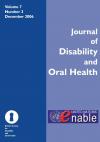Journal of Disability and Oral Health

- Cover Date:
- December 2006
- Print ISSN:
- 1470-8558
- Electronic ISSN:
- 1754-2758
- Vol:
- 7
- Issue:
- 3
Hypnosis – alternative, or complimentary to conscious sedation in dentistry? A review
Abstract This paper examines the use of hypnosis in general dentistry specifically in a sedation context, briefly looking at the history of hypnosis and our current understanding of it, before going on to describe its use as alternative and adjunct to conscious sedation. Hypnosis is an important and effective adjunct to sedation and this paper aims to give an overview of this relationship. However, there is limited qualitative and quantitative research in the literature examining the relationship between hypnosis and sedation, which makes in-depth discussion difficult. There is therefore a need for good experimental evidence. There will only be sufficient clinical data to move hypnosis from just an experimental interest, and to turn it into a viable treatment option for the mainstream holistic treatment of patients, if clinicians are willing to undertake objective research with this modality. The effects of hypnotic suggestion- motivation, removal of fear and doubt, fixation of attention, relaxation and limited voluntary movements, monotony, and suppression of other ideas, are all useful for patient management. Since these effects come from communication skills which are fundamental to dentistry, it has been suggested that knowledge of hypnotic techniques and principles is important for general patient management by all clinicians, whether or not they wish to use ‘formal’ hypnosis. Key words: Conscious sedation; hypnosis, dental fear
- Article Price
- £15.00
- Institution Article Price
- £15.00
- Page Start
- 156
- Page End
- 162
- Authors
- S. A. Thompson, S. M. Woolley
Articles from this issue
- Title
- Pg. Start
- Pg. End
- Defining the population requiring special care dentistry using the International Classification of Functioning, Disability and Health – a personal view
- 143
- 152
- Oral disease experience of adults with severe disability, prior to receiving dental treatment under general anaesthesia
- 173
- 175
